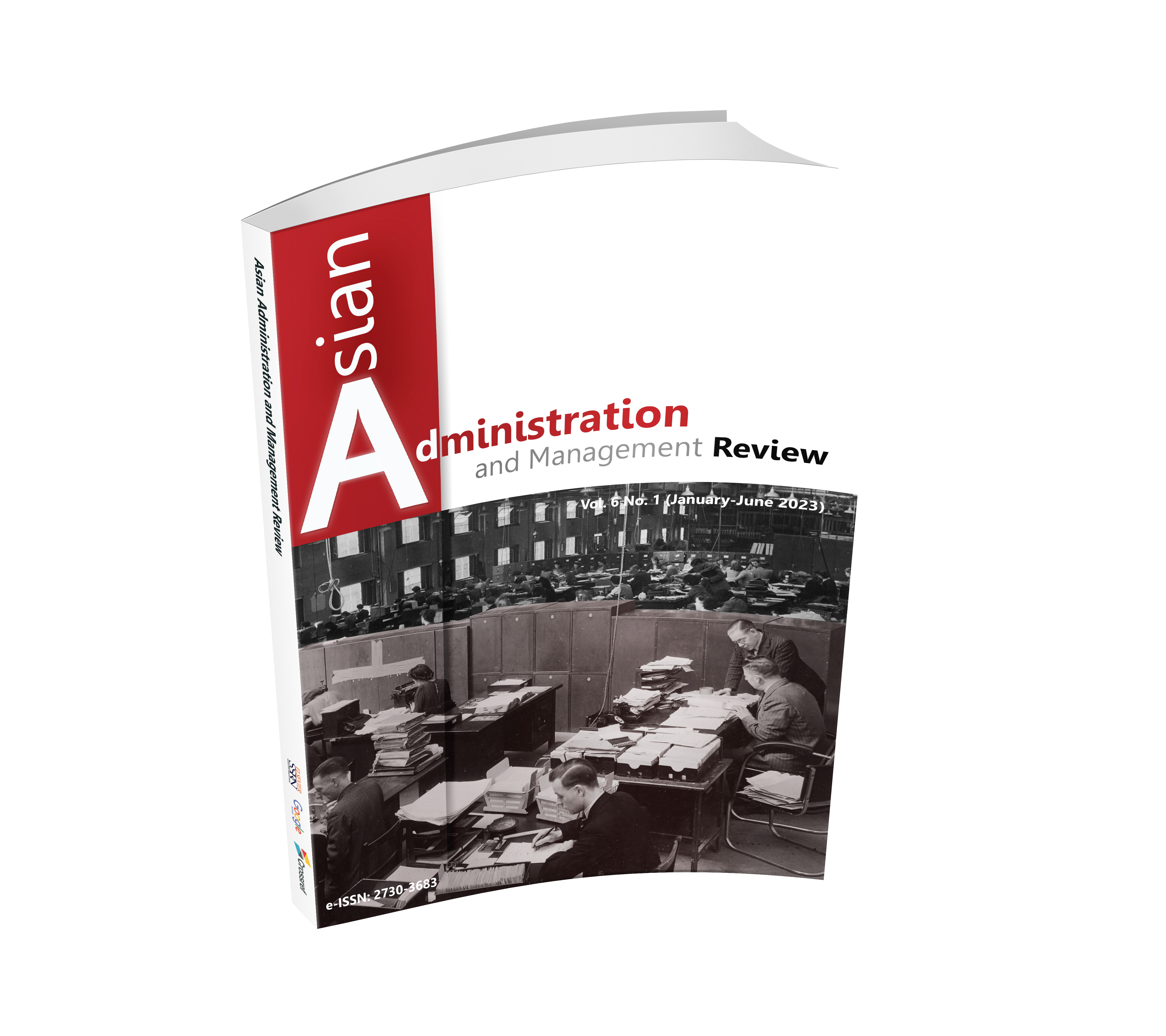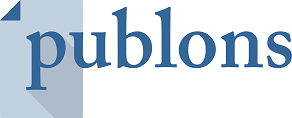THE RELATIONSHIP BETWEEN E-HRM PRACTICES AND ORGANIZATIONAL PERFORMANCE: THE MEDIATING ROLE OF ORGANIZATIONAL AGILITY AND SUSTAINABLE COMPETITIVE ADVANTAGE
DOI:
https://doi.org/10.14456/aamr.2023.8Keywords:
E-HRM Practices, Organizational Agility, Sustainable Competitive Advantage, Organizational PerformanceAbstract
Electronic Human Resource Management (E-HRM) is an act of improving the HRM functions to create dynamic and operational capabilities and contributes greatly on organizational performance. This paper examines the relationship between E-HRM practices, organizational agility, sustainable competitive advantage and organizational performance. We conduct a large scale survey of 317 SMEs in Thailand. Data analysis was performed using Pearson correlation analysis, multiple hierarchical regression techniques and structural equation modelling. Results of the study suggest that organizational agility mediates the influence of E-HRM practices on organizational performance. The study also found that E-HRM practices indirectly through sustainable competitive advantage influences organizational performance. The findings suggest the key organizational agility and sustainable competitive advantage include speed, responsiveness, flexibility, competency, operational effectiveness, relational effectiveness, and strategic effectiveness. Through finding this paper contributes to the emerging literature on E-HRM and has practical implication for organization adapting to achieve organizational performance.
Downloads
References
Aamer, A., Al-Awlaqi, M., & Mandahawi, N. (2020). Insights into the reasons behind the limited implementation of ISO 9001 certification: empirical evidence from Yemen. The TQM Journal, 33(2), 358-378.
Abraham, M., Niessen, C., Schnabel, C., Lorek, K., Grimm, V., Möslein, K., & Wrede, M. (2019). Electronic monitoring at work: The role of attitudes, functions, and perceived control for the acceptance of tracking technologies. Human Resource Management Journal, 29(4), 657-675.
Akkaya, B., & Mert, G. (2022). Organizational Agility, Competitive Capabilities, and the Performance of Health Care Organizations During the Covid-19 Pandemic. Central European Management Journal, 30(1), 2-25.
Akkaya, B., & Tabak, A. (2020). The link between organizational agility and leadership: A research in science parks. Academy of Strategic Management Journal, 19(1), 1-17.
Alaali, N., Al-Marzouqi, A., Albaqaeen, A., Dahabreh, F., Alshurideh, M., Mouzaek, E., & Aburayya, A. (2021). The impact of adopting corporate governance strategic performance in the tourism sector: A case study in the Kingdom of Bahrain. Journal of Legal, Ethical and Regulatory Issues, 24(1), 1-18.
Alameeri, K., Alshurideh, M., Kurdi, B., & Salloum, S. (2020). The effect of work environment happiness on employee leadership. A paper presented at the 6th International Conference on Advanced Intelligent Systems and Informatics, Cairo, Egypt.
Alegre, J., & Sard, M. (2015). When demand drops and prices rise. Tourist packages in the Balearic Islands during the economic crisis. Tourism Management, 46, 375-385.
Alkalha, Z., Al-Zu’bi, Z., Al-Dmour, H., Alshurideh, M., & Masa’deh, R. (2012). Investigating the effects of human resource policies on organizational performance: An empirical study on commercial banks operating in Jordan. European Journal of Economics, Finance and Administrative Sciences, 51(1), 44-64.
Al-kasasbeh, A., Halim, M., & Omar, K. (2016). E-HRM, workforce agility and organizational performance: A review paper toward theoretical framework. International Journal of Applied Business and Economic Research, 14(15), 10671-10685.
Alkhodary, D. (2021). The Impact of E-HRM on Corporates Sustainability: A study on the SMEs in Jordan. International Journal of Entrepreneurship, 25(6), 1-15.
Alrawashdeh, N., Zaki, N., Yusof, J., & Mat, N. (2021). Electronic Human Resource Management Practices, Information Technology Capability and Organisational Performance: A Review Paper Toward Conceptual Framework. Turkish Journal of Computer and Mathematics Education, 12(13), 874-884.
Alsuwaidi, M., Alshurideh, M., Kurdi, B., & Salloum, S. (2020). Performance appraisal on employees’ motivation: A comprehensive analysis. A paper presented at the 6th International Conference on Advanced Intelligent Systems and Informatics, Cairo, Egypt.
Asante, B., & Adu-Damoah, M. (2018). The impact of a sustainable competitive advantage on a firm’s performance: Empirical evidence from Coca-Cola Ghana limited. Global Journal of Human Resource Management, 6(5), 30-46.
Ashrafi, A., Ravasan, A., Trkman, P., & Afshari, S. (2019). The role of business analytics capabilities in bolstering firms’ agility and performance. International Journal of Information Management, 47, 1-15.
Baah, C., & Jin, Z. (2019). Sustainable supply chain management and organizational performance: the intermediary role of competitive advantage. Journal of Management and Sustainability, 9(1), 119-131.
Battour, M., Barahma, M., & Al-Awlaqi, M. (2021). The Relationship between HRM Strategies and Sustainable Competitive Advantage: Testing the Mediating Role of Strategic Agility. Sustainability, 13(9), 5315.
Bondarouk, T., & Ruël, H. (2009). Electronic Human Resource Management: challenges in the digital era. The International Journal of Human Resource Management, 20(3), 505-514.
Braunscheidel, M., & Suresh, N. (2009). The organizational antecedents of a firm’s supply chain agility for risk mitigation and response. Journal of operations Management, 27(2), 119-140.
Chamanifard, R., Nikpour, A., Chamanifard, S., & Nobarieidishe, S. (2015). Impact of organizational agility dimensions on employee’s organizational commitment in Foreign Exchange Offices of Tejarat Bank, Iran. European Online Journal of Natural and Social Sciences: Proceedings, 4(1), 199-207.
Dabiri, S., & Gholami, A. (2015). Surveying the effect of strategic agility on gaining competitive advantage in Gachsaran oil and gas exploitation company. Journal of Renewable Natural Resources Bhutan, 3(6), 196-207.
Daou, A., Karuranga, E., & Su, Z. (2013). Intellectual capital in Mexican SMEs from the perspective of the resource-based and dynamic capabilities views. Journal of Applied Business Research, 29(6), 1673-1688.
Darvishmotevali, M., Altinay, L., & Köseoglu, M. (2020). The link between environmental uncertainty, organizational agility, and organizational creativity in the hotel industry. International journal of hospitality management, 87, e102499.
Di Minin, A., Frattini, F., Bianchi, M., Bortoluzzi, G., & Piccaluga, A. (2014). Udinese Calcio soccer club as a talents factory: Strategic agility, diverging objectives, and resource constraints. European Management Journal, 32(2), 319-336.
Doz, Y., & Kosonen, M. (2010). Embedding strategic agility: A leadership agenda for accelerating business model renewal. Long range planning, 43(2), 370-382.
Ebrahim, A. (2021). The Impact of Human Resource Management Practices on Organizational Agility Through Knowledge Management Processes as an Intermediate Variable. Arab Journal of Administration, 41(1), 289-310.
Emeagwal, L., & Ogbonmwan, K. (2018). Mapping the perceived role of strategic human resource management practices in sustainable competitive advantage. Academy of Strategic Management Journal, 17(2), 1-19.
Fahy, J. (2000). The resource-based view of the firm: some stumbling-blocks on the road to understanding sustainable competitive advantage. Journal of European industrial training, 24(2), 94-104.
Friedman, B. (2007). Globalization implications for human resource management roles. Employee Responsibilities and Rights Journal, 19(3), 157-171.
Ghazzawi, K., Al-Khoury, P., & Saman, J. (2014). The effect of implementing technology in HRM on the level of employee motivation. Human Resource Management Research, 4(2), 33-39.
Govuzela, S., & Mafini, C. (2019). Organizational agility, business best practices and the performance of small to medium enterprises in South Africa. South African Journal of Business Management, 50(1), 1-13.
Guimarães, J., Severo, E., & Vasconcelos, C. (2017). Sustainable competitive advantage: a survey of companies in Southern Brazil. Brazilian Business Review, 14(3), 352-367.
Hamidianpour, F., Esmaeilpour, M., & Firoozi, H. (2016). Assessing the impact of electronic human resource management on creation of organizational agility: A study in the Bushehr Banks, Iran. Asian Social Science, 12(7), 105-118.
Karanja, M. (2017). The Effect of Risk Management Strategies on The Sustainable Competitive Advantage of Commercial Banks in Kenya. Master of Business Administration Thesis, University of Nairobi.
Kavosi, Z., Delavari, S., Kiani, M., Bastani, P., Vali, M., & Salehi, M. (2021). Modeling organizational intelligence, learning, forgetting and agility using structural equation model approaches in Shiraz University of Medical Sciences Hospitals. BMC research notes, 14(1), 1-8.
Khashman, A., & Al-Ryalat, H. (2015). The impact of electronic human resource management (E-HRM) practices on business performance in Jordanian telecommunications sector: The employee’s perspective. Journal of Management Research, 7(3), 115-129.
Kim, K., Jeon, B., Jung, H., Lu, W., & Jones, J. (2011). Effective employment brand equity through sustainable competitive advantage, marketing strategy, and corporate image. Journal of Business Research, 64(11), 1207-1211.
Kising, T., Namusonge, P., & Mwirigi, D. (2016). The role of organizational innovation in sustainable competitive advantage in Universities in Kenya. The International Journal of Social Sciences and Humanities Invention, 3(9), 2762-2786.
Kotler, P., & Keller, K. (2011). Marketing management. 4th ed. New Jersey: Pearson Prentice Hall.
Kuleelung, T., & Ussahawanitchakit, P. (2015). Organizational agility and firm performance: evidence from information and communication technology (ICT) businesses in Thailand. The Business & Management Review, 7(1), 206-217.
Lengnick-Hall, M., & Moritz, S. (2003). The impact of e-HR on the human resource management function. Journal of labor research, 24(3), 365-379.
Masum, A., Mamun, A., Islam, M., & Beh, L. (2020). The Impact of eHRM Practice on Organizational Performance: Investigating the Effect of Job Satisfaction of HRM Professionals. Journal of Computer Science, 16(7), 983-1000.
Mavengere, N. (2014). Role of information systems for strategic agility in supply chain setting: Telecommunication industry study. Electronic Journal of Information Systems Evaluation, 17(1), 100-112.
Mosahkani, M., Manian, A., Hoseingolipour, T., & Mirbaha, O. (2011). Proposing e model for the development of electronic human resource management in Iran's public organizations. Journal of Research of Public Management, 14(4), 41-62.
Nivlouei, F. (2014). Electronic human resource management system: The main element in capacitating globalization paradigm. International Journal of Business and Social Science, 5(2), 147-159.
Poba-Nzaou, P., Uwizeyemunugu, S., & Laberge, M. (2020). Taxonomy of business value underlying motivations for e-HRM adoption: an empirical investigation based on HR processes. Business Process Management Journal, 26(6), 1661-1685.
Pratheepan, S., & Arulrajah, A. (2012). Application of Electronic human resource management (E-HRM) practices and its effectiveness in selected private banks in Sri Lanka: An Exploration. A paper presented at the 7th International Research Conference on Management and Finance, University of Sri Jayewardenepura, Sri Lanka.
Rangarao, J., & Raju, S. (2014). e-HRM add value to the Human Resource Management to obtain optimum potentials from the available Human Resources. Indian Journal of Commerce and management, 1(1), 1-9.
Rijkers, B., Arouri, H., Freund, C., & Nucifora, A. (2014). Which firms create the most jobs in developing countries? Evidence from Tunisia. Labour Economics, 31, 84-102.
Sagum, R. (2015). Electronic Human Resource Management Adoption in the State Universities of the Philippines. International journal of information technology and business management, 40(1), 39-46.
Saha, N., Gregar, A., & Sáha, P. (2017). Organizational agility and HRM strategy: Do they really enhance firms’competitiveness?. International Journal of Organizational Leadership, 6(3), 323-334.
Salih, A., & Alnaji, L. (2014). Impact of strategic thinking and strategic agility on strategic performance: A case study of Jordanian insurance industry companies. International Review of Management and Business Research, 3(4), 1871-1882.
Shamout, M., Elayan, M., Rawashdeh, A., Kurdi, B., & Alshurideh, M. (2022). E-HRM practices and sustainable competitive advantage from HR practitioner’s perspective: A mediated moderation analysis. International Journal of Data and Network Science, 6(1), 165-178.
Shill, W., Engel, J., Mann, D., & Schatteman, O. (2012). Six ways to make volatility your friend. Accenture Outlook. The Journal of High-performance Business, 3(1), 637-645.
Srivastava, S. (2010). Shaping Organization with e-HRM. International Journal of Innovation, Management and Technology, 1(1), 47-50.
Stone, D., & Lukaszewski, K. (2009). An expanded model of the factors affecting the acceptance and effectiveness of electronic human resource management systems. Human Resource Management Review, 19(2), 134-143.
Strohmeier, S. (2007). Research in e-HRM: review and implications. Human Resource Management Review, 17(1), 19-37.
Supriyadi. (2020). Strategic Sustainable Competitive Advantages of Firms performance. International Journal of Business and Management Invention, 9(3), 25-37.
Teece, D., Pisano, G., & Shuen, A. (1997). Dynamic capabilities and strategic management. Strategic Management Journal, 18(7), 509-533.
Thathsara, A., & Sutha, J. (2021). Investigating the influence of E-HRM practices on organizational performance: The mediating role of organizational agility (with special reference to financial institution). International Journal of Engineering and Management Research, 11(1), 1-8.
Ulrich, D., & Yeung, A. (2019). Agility: The new response to dynamic change. Strategic HR Review, 18(4), 161-167.
Winarto, W. (2018). Electronic Human Resources Management (E-HRM) adoption studies: past and future research. DeReMa Jurnal Manajement (Development Research of Management), 13(1), 100-120.

Downloads
Published
How to Cite
Issue
Section
License
Copyright (c) 2023 Authors

This work is licensed under a Creative Commons Attribution-NonCommercial-NoDerivatives 4.0 International License.











.png)


